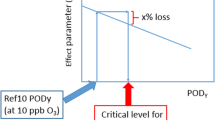Abstract
Ozone concentrations were measured at a wind-exposed edge of a 60 year-old 15–20 m tall Norway spruce forest in south-west Sweden and simultaneously over a barley field 5 km away for 27 days, At the forest site, measurements were performed at 3 and 13 m height 15 m in front of the forest edge, at 3 m height 15 m into the forest, and at 3 and 13 m height 45 m into the forest. Measurements at 3 m were made with three replicate tubes separated by 10 m. Differences between replicates were small. At 13 m height, the concentration (24-hr-average) 45 m into the forest was 95% of that in front of the forest edge. The average concentration at 3 m height did not vary strongly with the distance into the forest, but was 86% of that at 13 m in front of the forest edge. For AOT40 (Accumulated Exposure Over Threshold 40 ppb ozone), the differences between different positions were larger. At the 13 m level the AOT40 (day and night) was 88% of that in front of the forest 45 m into the forest. The AOT40 at 3 m was 71% of that at 13 m outside the forest. At the crop site, the ozone concentration at 1.1 m (0.1 m above the canopy), was 78% of that at 9 m (06.00–22.00). The AOT40 at 1.1 m above the ground, however, was only 50% of that at 9 m, indicating that serious errors can arise if ozone monitoring data are used uncorrnected in dose-response relationships based on measurements performed at plant height. The ozone concentration for the whole period differed very little between 9 m height at the crop site and 13 m height at the forest site outside the forest during daytime conditions (06.00–22.00). Night-time (22.00–06.00) values were only 21% at the crop site of those at the forest site due to the stronger night inversion development in the agricultural environment compared to the wind exposed forest edge. The results suggest that variations in topography and vegetation are important to consider when combining ozone monitoring data with dose-response functions.
Similar content being viewed by others
References
Ashmore, M.R. & Wilson, R.B. (Eds): 1994,Critical Levels of Air Pollutants for Europe, Department of the Environment, UK, 209 pages.
Fuhrer, J. & Achermann, B.: 1994, Critical levels for ozone. A UN-ECE workshop report,Schriftreihe der FAC Liebefeld 16, 328 pages.
Guderian, R.: 1988, Critical levels for effects of ozone (O3), In:Final Draft Report of UNECE Critical Levels Workshop, Bad Harzburg, 51–78.
Jarvis, P. G. and McNaughton, K. G.: 1986,Advances in Ecological Research 15, 1–49.
Pleijel, H., Wallin, G., Karlsson, P., Skärby, L., Selldén G.: 1994,Atmospheric Environment 28, 1971–1979.
Tuovinen, J.-H. & Laurila, T.: 1993, “Ozone concentration and exposures in Finland”, In (Ed) Antila, P.:Proceedings of EMEP Workshop on the Control of Photochemical Oxidants in Europe, April 20–22, 1993, Porvoo, Finland, 15–24.
Author information
Authors and Affiliations
Rights and permissions
About this article
Cite this article
Pleijel, H., Wallin, G., Karlsson, P. et al. Gradients of ozone at a forest site and over a field cropconsequences for the AOT40 concept of critical level. Water Air Soil Pollut 85, 2033–2038 (1995). https://doi.org/10.1007/BF01186133
Issue Date:
DOI: https://doi.org/10.1007/BF01186133




